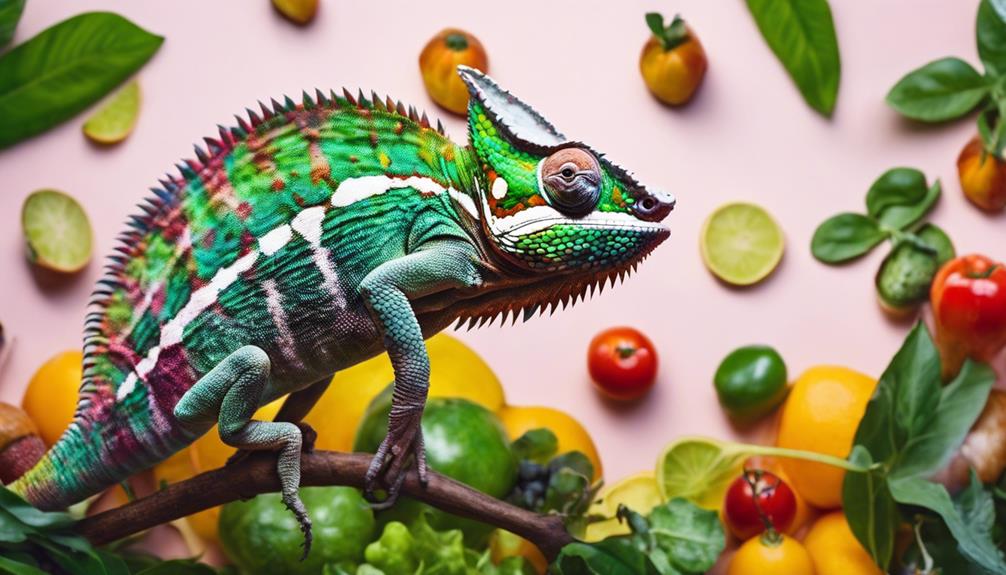If you’ve ever wondered about the endurance of a chameleon when it comes to food consumption, you might find the insights in this guide quite intriguing.
Understanding how long a chameleon can go without eating involves more than just a simple timeframe. Factors like adaptation, environment, and importance play significant roles.
So, how long can these remarkable creatures truly sustain themselves without indulging in a meal? The answer might surprise you.
A chameleon can survive without food for up to two weeks, but the longer it goes unfed, the weaker it becomes. They typically eat every few days to maintain their health.
Chameleon Dietary Needs
Chameleons rely on a diet primarily consisting of insects such as crickets, grasshoppers, locusts, flies, worms, slugs, and snails for their nutritional needs. These insects provide essential nutrients like protein, vitamins, and minerals important for the chameleons’ overall health. While some species may occasionally consume plant matter, small birds, rodents, or other lizards, insects remain the cornerstone of their diet.
When it comes to feeding, baby chameleons have higher dietary demands than adults. They require daily meals, devouring up to 15 insects each day to support their rapid growth and development. In contrast, adult chameleons typically feed on around 6 insects per meal and may not need to eat every day due to their slower metabolism. This ability to go without food for days is an adaptation to their natural environment, where food sources may not be consistently available.
For chameleons kept as pets, replicating their insect-rich diet is important for their well-being. Ensuring a variety of insects is provided helps mimic their natural feeding habits and provides them with the necessary nutrients. Additionally, offering regular access to clean water is essential as chameleons may obtain some hydration from the insects they consume. Meeting these dietary needs is fundamental to maintaining the health and vitality of these fascinating reptiles.
Factors Influencing Chameleon Survival
Factors impacting chameleon survival include their ability to regulate metabolism and adjust feeding patterns based on environmental conditions. Chameleons can go up to two weeks without food due to their slow metabolism, which allows them to conserve energy efficiently. Young chameleons, with their higher food requirements, may not last as long without eating compared to adults, who’ve lower energy needs. In the wild, chameleons adapt to food availability by eating less frequently, showcasing their ability to survive in varying conditions.
Additionally, the health, age, and activity levels of chameleons play significant roles in determining how long they can go without food. A healthy chameleon is more likely to withstand longer periods without eating compared to one that’s already compromised. Young chameleons, being in their growth phase, require more frequent feeding to support their development, whereas adults can sustain themselves for longer durations. Additionally, the activity levels of chameleons affect their energy expenditure, influencing the time they can survive without food. Understanding these factors is important in ensuring the well-being and survival of chameleons in different environments.
Signs of Chameleon Refusing Food
When noticing a chameleon’s reluctance to consume food, various indicators can provide insight into their well-being and potential underlying issues.
- Lethargy: A chameleon that’s refusing food may display lethargic behavior, such as reduced movement and overall sluggishness.
- Closed Eyes: Another sign of a chameleon refusing food is the frequent closure of their eyes, indicating discomfort or distress.
- Weight Loss: Sudden weight loss or a noticeable decrease in the chameleon’s body mass can be a clear indication that they aren’t eating adequately.
Chameleons may refuse food for various reasons, including feeling threatened or stressed in their environment. Illness can also lead to a loss of appetite in chameleons, making it important to monitor their behavior closely. If a chameleon has overeaten or consumed something that caused digestive issues in the past, they might refuse food as a precautionary measure.
Understanding these signs of chameleon refusing food is essential for promptly addressing any underlying problems and ensuring the well-being of your pet.
Tips to Encourage Chameleon Eating
To effectively encourage your chameleon to eat, provide a diverse selection of live insects such as crickets, grasshoppers, and mealworms. Chameleons are more likely to eat when presented with a variety of prey options. Make sure that the insects you offer are appropriately sized for your chameleon’s age and size. Feeding insects that are too large can be important and lead to a lack of appetite.
Using essential insects is important to provide necessary nutrients to your chameleon. Gut-loading involves feeding the insects a nutritious diet before offering them to your pet. This ensures that the chameleon receives a well-rounded meal with all the necessary vitamins and minerals. Additionally, dusting the insects with calcium and vitamin supplements before feeding can help meet your chameleon’s dietary requirements.
Monitoring your chameleon’s weight and behavior is important to track their eating habits. Keep a close eye on how much food they consume and their overall well-being. If you notice any significant changes, it may be necessary to adjust your feeding strategies accordingly.
Understanding Chameleon’s Feeding Patterns
Encouraging your chameleon to eat a diverse selection of live insects is key to understanding their feeding patterns. When it comes to chameleons, their diet plays an important role in their overall health and well-being. Here are some essential points to take into account about chameleons’ feeding habits:
- Chameleons need a varied diet: Providing a variety of insects such as crickets, roaches, and mealworms ensures that your pet chameleon receives all the essential nutrients it needs to thrive.
- Chameleons eat according to their age: Young chameleons have higher metabolisms and hence require more frequent feeding compared to adult chameleons. Making sure that young chameleons are fed appropriately is important for their growth and development.
- Chameleon refuses to eat: If your chameleon refuses to eat, it could be a sign of stress, illness, or incorrect husbandry. Monitoring your chameleon’s eating habits is important, and any prolonged lack of appetite should be addressed promptly to safeguard your pet’s well-being.
Understanding the feeding patterns of chameleons in captivity is important for maintaining their health. By providing a suitable diet, monitoring their food intake, and recognizing signs of refusal to eat, you can make sure that your chameleon stays healthy and happy.
Frequently Asked Questions
How Long Can a Chameleon Stay Without Eating?
You can’t ignore survival instincts. Chameleons have impressive fasting capabilities due to energy reserves and metabolic rates. Consider their adaptation strategies during hibernation periods. Guarantee their nutritional requirements, water intake, and environmental factors are met to avoid health implications.
Can You Leave a Chameleon Alone for a Week?
You can confidently leave a chameleon alone for a week if it’s healthy and well-fed. Their survival instincts and adaptability enable them to manage without food for about seven days. Guarantee proper hydration and monitor behavior post-return for adjustments.
Do Chameleons Need to Be Fed Every Day?
Chameleons do not need to be fed every day. Their feeding schedule depends on age and size. Baby chameleons require daily feeding while adults can eat every other day or less. Monitoring their nutritional needs is crucial.
What Does a Malnourished Chameleon Look Like?
When a chameleon is malnourished, signs like sunken eyes, weak muscles, and dry skin appear. Lethargy, reduced appetite, and spine prominence indicate malnutrition. Prevent this by offering a balanced diet and seeking vet care for a malnourished chameleon.
Conclusion
You now understand the intricate dietary needs of chameleons and the various factors that can affect their ability to go without eating. By recognizing signs of refusal and implementing strategies to encourage eating, you can guarantee the well-being and survival of these fascinating creatures.
Remember to stay observant of their feeding patterns and provide the necessary care to keep them healthy and thriving. The truth is, with proper care and attention, chameleons can go without eating for extended periods, but it’s essential to monitor their health closely.


